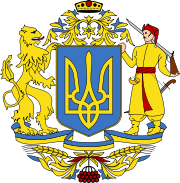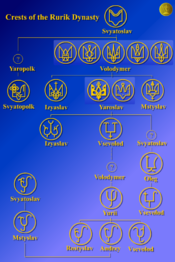Coat of arms of Ukraine
| Coat of arms of Ukraine | |
|---|---|
 |
|
| Versions | |
 Great Coat of Arms of Ukraine (not officially adopted). |
|
| Details | |
| Armiger | Government of Ukraine |
| Adopted | 19 February 1992 |
| Escutcheon | Azure, a Tryzub Or |
The State Coat of Arms of Ukraine (Ukrainian: Державний Герб України) or commonly the Tryzub (Ukrainian: Тризуб, "trident") is the national coat of arms of Ukraine, featuring the same colors found on the Ukrainian flag; a blue shield with yellow trident, called the tryzub. It appears on the Presidential standard of Ukraine.
The small coat of arms was officially adopted on 19 February 1992, while constitutional provisions exist for establishing the great coat of arms, which is not yet officially adopted.
Contents |
History


 |
 |
|
|
The Ukrainian trident overprint of May 1919 on a five-heller stamp of Austria-Hungary (left). The Tryzub on the Small Coat of Arms of the Ukrainian People's Republic (right).
|
||
The history of the trident symbol as featured in the current Ukrainian coat of arms is more than 1000 years old. The first known archeological and historical evidence of this symbol can be found on the seals of the Rurik dynasty. The tryzub was stamped on the gold and silver coins issued by Prince Vladimir the Great (980–1015), might have inherited the symbol from his ancestors (such as Sviatoslav I Igorevich) as a dynastic coat of arms and passed it on to his sons, Sviatopolk I (1015–19) and Yaroslav the Wise (1019–54).
The tryzub was also found on the bricks of the Church of the Tithes in Kiev, the tiles of the Dormition Cathedral in Volodymyr-Volynskyi, and the stones of other churches, castles, and palaces. There are many examples of it used on ceramics, weapons, rings, medallions, seals, and manuscripts. Since the tryzub was so widely used, it evolved many variations without losing its basic structure. Almost 200 medieval variations of the tryzub have been discovered in Ukraine.
Interpretation
There is no sure and definite interpretation of the symbol, however, most historians agree that it most probably depicts a stylized falcon which according to the Slavic mythology was the Primary god (Pershoboh).[1] The use of this symbol has been supplanted since the 11th century by the Christian tradition of using the images of the saints (most notably Saint George or Saint Michael) considered to be the protectors of the ruling family, and later by Galician or Cossack heraldic or cultural images. Theory goes that the trident (tryzub - three-tooth) is composed of the Ukrainian letters for word Freedom (ВОЛЯ) pronounced VOLYA.
The trident was not thought of as a national symbol until 1917, when one of the most prominent Ukrainian historians, Mykhailo Hrushevsky, proposed to adopt it as a national symbol (alongside other variants, including an arbalet, a bow or a cossack carrying a musket, i.e. images that carried considerable historical and cultural and heraldic significance for Ukraine). On 22 March 1918, the Central Rada (parliament) adopted it as the coat of arms of the short-lived Ukrainian People's Republic.
Great Coat of Arms
Constitutional provisions exist for the establishment of a Great Coat of Arms of Ukraine,[2] although it was never officially adopted and was published in various heraldic sources. In this variant, the shield is supported by a lion from the Galician Coat of Arms on the left and a Cossack in traditional dress, wielding a musket, the symbol of the Cossack Hetmanate on the right. The Coat of Arms is crowned with the crown of Vladimir the Great, symbolizing Ukrainian sovereignty and decorated with viburnum and wheat at the bottom.
The official adoption of the Great Coat of Arms has to be endorsed by a majority by two thirds vote in the Verkhovna Rada (Ukrainian parliament) because of the resistance of the Communist and pro-Russian parties.
Other uses
The tryzub was also used, in conjunction with the Russian tricolor, as the symbol of the anti-communist movement National Alliance of Russian Solidarists in the early 20th century.
References
- ↑ Serhiy Plachynda. The dictionary of Slavic mythology. (Ukrainian)
- ↑ Constitution of Ukraine, Article 20.
- Pritsak, Omeljan (1998). The Origins of the Old Rus' Weights and Monetary Systems. Cambridge, Massachusetts: Harvard Ukrainian Research Institute. ISBN 0916458482.
- Zhukovsky, Arkadii (1993). "Trident (tryzub)". Encyclopedia of Ukraine. vol. 5. http://www.encyclopediaofukraine.com/display.asp?linkPath=pages\T\R\Trident.htm. Retrieved 2009-03-26.
|
|||||||||||||||||||||||||||||
|
||||||||||||||